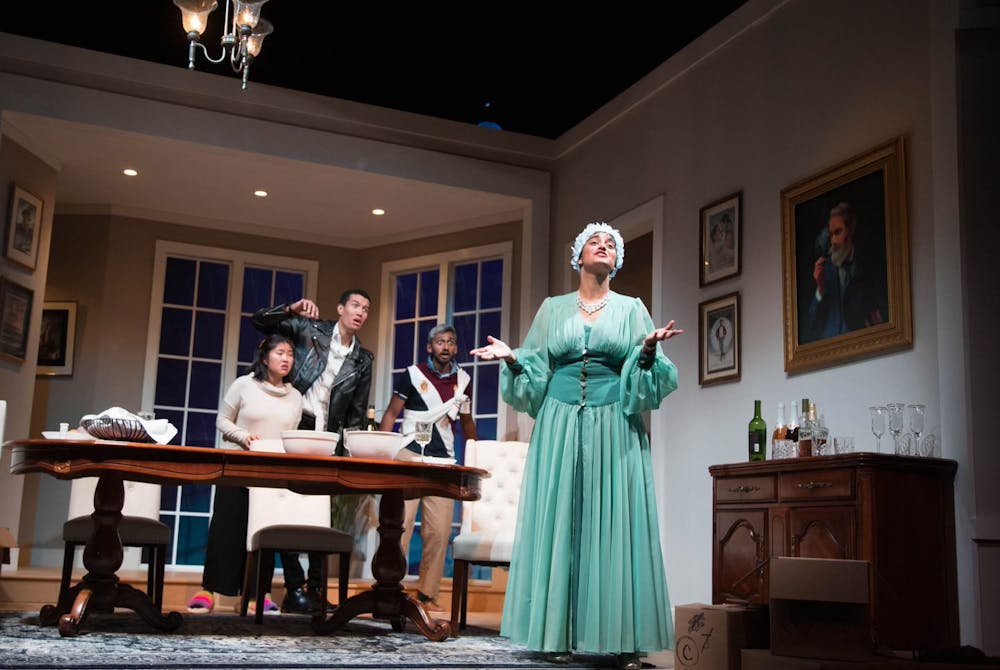“Two Mile Hollow,” the Department of Theatre Arts and Performance Studies’ first show of its 2022-23 performance season, opened Nov. 3 at Stuart Theater and will run until Nov. 13. Written by playwright Leah Nanako Winkler and directed by Carol Ann Tan MFA’23, the show stands out from many of the department’s previous offerings: Winkler requires that all roles be played by actors of color in performances of “Two Mile Hollow.”
The play follows the rich, white, pretentious Donnelly family, as they host their final gathering at their recently-sold estate, called Two Mile Hollow. The play’s cast consists of five roles: matriarch and widow Blythe Donnelly; her movie star stepson Christopher; her other, far less successful stepson Joshua; her insecure daughter Mary and Charlotte, Christopher’s personal assistant, who is the only written non-white character in the play. Over dinner, drinks and a thunderstorm, secrets begin to unravel and the Donnellys begin to break down. Their dysfunction is revealed in both sincere and comic moments. In these revelations, the play comments on traditional white American theater.
“The play is satire,” said actor Mia Lane ’24, who plays Blythe Donnelly in the production. “It’s sort of riffing on that genre of white people gathering by the water.”
For Tan, the play was an opportunity to lean into ridiculousness. “The play itself is really wild,” she said. “I really enjoy just trying to crack open the idea of what it means to just have a ridiculous amount of fun, both in the process and in the final product.”
Something that Tan centers in her directing is bringing “rigorous joy” to the set. “It’s serious, but it’s also not that serious,” she said.
Blythe embodied the fun of the play more than any other character, Lane said. “Blythe is very much the sort of character that I normally go for,” she said. “She’s very wacky, sort of demands attention every time she comes on stage and has these big rambling monologues. She’s quite an unreasonable character. She’s always pushing the boundaries of what’s acceptable.”
Lane found Tan’s directing process incredibly helpful in bringing a character as eccentric as Blythe Donnelly to life. “She would always use this phrase — ‘I have an offering for you’ — when she was giving us her notes and her direction,” she said. “She wanted us to understand these characters and embody (them) on our own.”
The earnest efforts by the cast to deeply lean into their roles did not go unrecognized by the audience. Dena Salliey ’24, an audience member at the show’s opening, said that she was “surprised at how genuinely funny the show was.” In particular, she enjoyed “how all of the actors really embraced their characters and pulled you into their different plot lines.”
Although Tan did not change much from Winkler’s original script, she did decide to approach “Two Mile Hollow” through a “lens of contemporary absurdism.”
“(We’re putting) on this world that is fundamentally fictional and unreal, and asking people to believe in it,” Tan said. She called this the “fundamental ask” of theater, adding that it mirrors the absurdism of the post-pandemic world.
Tan actually had considerable experience with “Two Mile Hollow” before bringing it to Stuart Theater. She was directly involved in the play’s rolling world premiere in 2017 and was asked to take on the role of dramaturg in the Chicago production.
“What drew me to the play then and still draws me to the play now is this idea that it creates this open space for actors of color to be who they are and have fun,” she said. “It’s really for them to open up in this ridiculous, expansive way.”
Tan herself is Chinese-Singaporean. When she moved to the United States to attend college, she initially wanted to be an actor. But she “found it very difficult to get roles based on how I looked and how I sounded,” she said.
“I’m interested in creating a platform for people like myself to feel welcome in the American theater,” Tan added. “To feel that our voices are valid and our perspectives are valid.”
Lane said that “it’s been really lovely to have a space that’s just dedicated to performers of color.” She said she hopes that audience members will, by the end of the play, understand better how “the classic American canon of theater” is really tailored toward white performers. “So much of modern theater of the past 100 years is designated for a very specific set of actors,” Lane explained.
“In the past, a particular kind of story has always been privileged,” Tan said. But she added that “American society (is) changing, and the face of the American theater is changing. Should you come to see the show, you will see us.”

Rya is an Arts & Culture editor from Albany, NY. She is a senior studying English and Literary Arts, and her favorite TV show is Breaking Bad.





